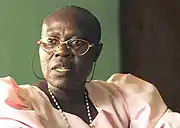Valérie Bemeriki
Valérie Bemeriki (born 1955)[4] is a Rwandan convicted war criminal and radio entertainer. Bemeriki was one of the main animatrices[3][5] of Radio Télévision Libre des Mille Collines (RTLM), which played a significant role in promoting the genocide against the Tutsi.
Valérie Bemeriki | |
|---|---|
 | |
| Born | 1955 (age 67–68) |
| Nationality | Rwandan |
| Occupation(s) | Radio presenter (animatrice), journalist |
| Criminal status | Incarcerated in Gikondo Prison (Kigali Central Prison, "1930"), Kigali,[2] Rwanda |
| Criminal charge | planning genocide, inciting violence, complicity in several murders (by a local Rwandan Gacaca court in 2009)[3] |
| Penalty | Life imprisonment[3] |
Biography
Although born in Rutshuru, Democratic Republic of Congo (then Belgian Congo), Bemeriki's hometown is Giciye commune, Gisenyi préfecture, in Rwanda.[1] Prior to working at RTLM, Bemeriki worked for the ruling MRND party as a propagandist, also writing for the Interahamwe's (MRND's youth wing) publication.[6]
On April 8, 1994, two days after the assassination of Rwandan president Juvénal Habyarimana, Bemeriki ironically noted on air that opposition members of the previous government "could not be found",[7] while several, such as prime minister Agathe Uwilingiyimana had already been murdered. Based on an encounter at an interview at the offices of RTLM, Roméo Dallaire, the Force Commander of UNAMIR, has described Bemeriki as "very aggressive".[8] On June 28, 1994, over a month after the interview, Bemeriki stated on-air that "Dallaire is the basis of this war".[9]
During the genocide, Bemeriki frequently read out names and addresses of Tutsis alleged to be "RPF accomplices",[10] which led to their murder by Hutu Power paramilitaries such as the Impuzamugambi and Interahamwe. Bemeriki was noted for presenting RTML's genocidal rhetoric through a colloquial type of tongue-in-cheek humor.
Bemeriki was an advocate of machetes as a murder weapon, and instructed viewers to "not kill those cockroaches with a bullet — cut them to pieces with a machete”. Bemeriki was one of the few major women who played a major role in the genocide, along with former Minister for Family Welfare and the Advancement of Women Pauline Nyiramasuhuko and former Minister of Justice Agnès Ntamabyaliro Rutagwera.[11] After Kantano Habimana, Bemeriki was the announcer with the second most airtime, approximately 17% of all RTLM broadcasts.[12] Following the genocide, Bemeriki was named[5] as one its 2,133 "planners, organizers, instigators, supervisors and leaders"[13] in accordance with the Genocide Law of the Republic of Rwanda (1996).[14]
Bemeriki fled Kigali for her native Zaire in July 1994[1] and was arrested in Minova, near Bukavu in the (by then renamed) Democratic Republic of the Congo on 13 June 1999 by the Rwandan military.[1][4][5] She was convicted of and pleaded guilty to planning genocide, inciting violence and complicity in several murders and sentenced to life imprisonment by a Gacaca court in 2009.[3][4] Bemeriki has acknowledged her role in the genocide and begged for forgiveness, but has claimed that she was merely acting under the pressure from her employer.[15]
References
- WK/DO/FH (22 June 1999). "VALERIE BEMERIKI, ANCIENNE JOURNALISTE DE RTLM ARRETEE, RECONNAÎT LES FAITS QUI LUI SONT REPROCHES". Hirondelle. Kigali, Rwanda.
- Brunner, Kira (2003). The New Killing Fields: Massacre and the Politics of Intervention. Basic Books. p. 119. ISBN 0465008046.
- "Rwanda jails journalist Valerie Bemeriki for genocide". BBC. London, UK. 14 December 2009. Archived from the original on 23 September 2023. Retrieved 17 March 2013.
- "Valerie Bemeriki". TRIAL (Swiss association against impunity). Archived from the original on 2013-04-08. Retrieved 2013-03-19.
- http://www.pulitzer.org/archives/6922 Archived 2023-09-23 at the Wayback Machine Olojede, Dele (4 May 2004). "When Words Could Kill". Newsday. New York City, NY, USA. Archived from the original on 23 September 2023. Retrieved 17 March 2013.
- Legatt-Smith, Yvonne (1995). Rwanda: Not So Innocent - When Women Become Killers. African Rights. p. 80. ISBN 1899477055.
- Melvern, Linda (2006). Conspiracy to Murder: The Rwandan Genocide. London, UK: Verso Books. p. 175. ISBN 1844675424.
- Dallaire, Roméo (2003). Shake Hands with the Devil. The Failure of Humanity in Rwanda. Random House Canada. p. 349. ISBN 978-0-679-31171-3.
- Archived 2023-09-23 at the Wayback Machine UN transcript; ICTR-99-52-T; June 28, 1994, P137B, p. 17
- Cotton, Cassandra (2007). "'Where Radio is King:' Rwanda's Hate Radio and the Lessons Learned". Atlantic International Studies Journal: 4–11. Archived from the original on 7 February 2013. Retrieved 17 March 2013.
- "When sons rape, kill at the command of mothers". The New Times | Rwanda. 2014-04-07. Archived from the original on 2023-09-23. Retrieved 2021-04-04.
- Thompson, Allan, ed. (2007). Kimani, Mary: RTLM: the Medium that Became a Tool for Mass Murder. In "The Media and the Rwanda Genocide". Pluto Press, Fountain Publishers, IDRC. p. 116. ISBN 978-0-74532-625-2. Archived from the original on 16 September 2013. Retrieved 19 March 2013.
- http://www.rwandaembassy.org/discover-rwanda/the-genocide-in-rwanda.html Archived 2013-03-30 at the Wayback Machine The Genocide in Rwanda: Rwanda Embassy, Washington, D.C., 08. January 2011
- http://www.unhcr.org/refworld/topic,463af2212,469f2d0c2,3df4bea428,0,,,.html Archived 2023-09-23 at the Wayback Machine Immigration and Refugee Board of Canada, Rwanda: Whether there is a "list" kept by the government of Hutus wanted in connection with the genocide (...) [accessed 17 March 2013]
- "Rwanda woman: I incited killings". The Independent. 2011-10-22. Archived from the original on 2023-09-23. Retrieved 2021-04-04.